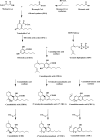Advancement of Research Progress on Synthesis Mechanism of Cannabidiol (CBD)
- PMID: 38900848
- PMCID: PMC11264327
- DOI: 10.1021/acssynbio.4c00239
Advancement of Research Progress on Synthesis Mechanism of Cannabidiol (CBD)
Abstract
Cannabis sativa L. is a multipurpose crop with high value for food, textiles, and other industries. Its secondary metabolites, including cannabidiol (CBD), have potential for broad application in medicine. With the CBD market expanding, traditional production may not be sufficient. Here we review the potential for the production of CBD using biotechnology. We describe the chemical and biological synthesis of cannabinoids, the associated enzymes, and the application of metabolic engineering, synthetic biology, and heterologous expression to increasing production of CBD.
Keywords: Cannabidiol (CBD); biosynthesis; cannabinoid; metabolic engineering; synthetic biology.
Conflict of interest statement
The authors declare no competing financial interest.
Figures





Similar articles
-
Designing microorganisms for heterologous biosynthesis of cannabinoids.FEMS Yeast Res. 2017 Jun 1;17(4):fox037. doi: 10.1093/femsyr/fox037. FEMS Yeast Res. 2017. PMID: 28582498 Free PMC article. Review.
-
Boosting the Cannabidiol Production in Engineered Saccharomyces cerevisiae by Harnessing the Vacuolar Transporter BPT1.J Agric Food Chem. 2022 Sep 28;70(38):12055-12064. doi: 10.1021/acs.jafc.2c05468. Epub 2022 Sep 19. J Agric Food Chem. 2022. PMID: 36122349
-
Heterologous production of Cannabis sativa-derived specialised metabolites of medicinal significance - Insights into engineering strategies.Phytochemistry. 2022 Nov;203:113380. doi: 10.1016/j.phytochem.2022.113380. Epub 2022 Aug 30. Phytochemistry. 2022. PMID: 36049526 Review.
-
Terpenes and Cannabinoids Yields and Profile from Direct-Seeded and Transplanted CBD-Cannabis sativa.J Agric Food Chem. 2022 Aug 31;70(34):10417-10428. doi: 10.1021/acs.jafc.1c06912. Epub 2022 Apr 18. J Agric Food Chem. 2022. PMID: 35436102
-
A new Cannabis genome assembly associates elevated cannabidiol (CBD) with hemp introgressed into marijuana.New Phytol. 2021 May;230(4):1665-1679. doi: 10.1111/nph.17243. Epub 2021 Feb 28. New Phytol. 2021. PMID: 33521943 Free PMC article.
References
-
- Fike J. Industrial Hemp: Renewed Opportunities for an Ancient Crop. Crit Rev. Plant Sci. 2016, 35 (5–6), 406–424. 10.1080/07352689.2016.1257842. - DOI
-
- Valizadehderakhshan M.; Shahbazi A.; Kazem-Rostami M.; Todd M. S.; Bhowmik A.; Wang L. J. Extraction of Cannabinoids from Cannabis sativa L. (Hemp)-Review. Agriculture 2021, 11 (5), 384.10.3390/agriculture11050384. - DOI
-
- Karche T.; Singh M. R. The Application of Hemp (Cannabis Sativa L.) for a Green Economy: a Review. Turk J. Bot 2019, 43 (6), 710–723. 10.3906/bot-1907-15. - DOI
Publication types
MeSH terms
Substances
LinkOut - more resources
Full Text Sources

